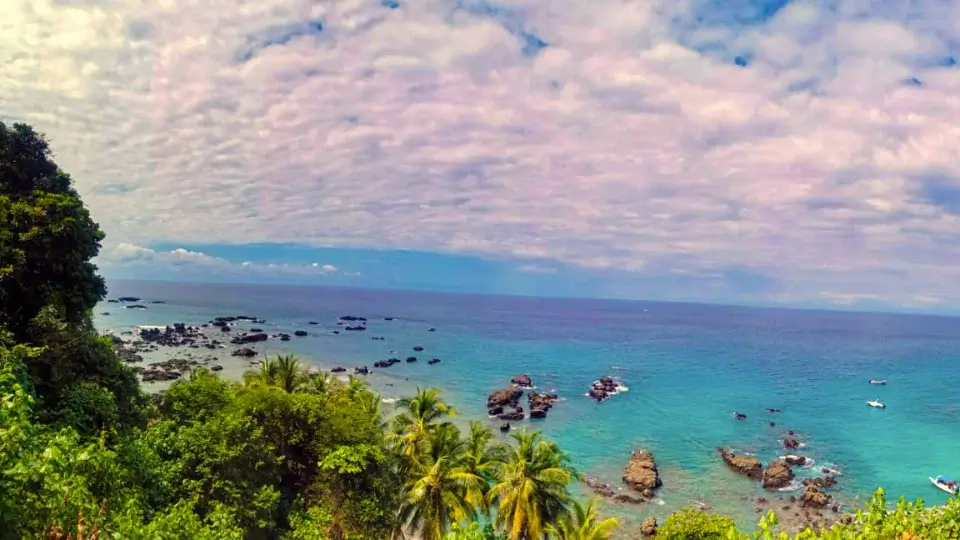An island wonderland
Cano Island Biological Reserve
Located 17km off the Uvita coast, Caño Island offers a unique blend of historical significance and natural wonder. While its terrestrial treasures include indigenous artifacts and sacred burial grounds, it's the underwater world that truly captivates visitors. With some of the clearest waters in Costa Rica, Cano Island promises unforgettable encounters for nature enthusiasts and snorkeling aficionados alike.



Cano Island Snorkeling
The snorkeling trip to Cano Island was fantastic! It’s a beautiful ride out to the island (about 1-1:20hr ride) but can be a bit rough for those who might get sea sick. The snorkeling visibility was excellent. Jellyfish were a bit of a nuisance. Nothing more than little, quick stings but irritating for those not prepared for it. Wearing long sleeve shirt/rash guard is very helpful. The guides were fantastic and very knowledgeable. We saw a ton of sea life, including multiple sea turtles. After snorkeling, there was a report of whale sightings so we bypassed getting off on the island, ate a quick lunch (which was fantastic!) and went to see a mama humpback and her baby! Awesome day. Would highly recommend!
Costa Rica's best snorkeling on the Pacific coast
Adventure to an uninhabited island
A hidden gem off Costa Rica’s southern Pacific coast, Cano Island Biological Reserve is dream come true for nature-lovers. With Cano Island just 17 km west of the Osa Peninsula, it’s an easy day trip that promises unforgettable underwater encounters in some of the clearest waters in Costa Rica.
For the adventurous family it’s a perfect blend of education and excitement. Imagine your children’s eyes widening as they spot breaching humpback whales or jumping dolphins on the boat ride out, and then come face-to-face with colorful reef fish, graceful sea turtles.
Cano Island offers an accessible and enriching experience for those seeking to connect with nature.
Snorkeler’s paradise: Uvita to Cano Island adventure
For snorkeling enthusiasts, Cano Island is the best place to snorkel on Costa Rica’s Pacific coast. It’s an underwater heaven with an astounding array of marine life that includes:
- tropical reef fish
- manta rays
- white-tipped reef sharks
- olive ridley sea turtles
- humpback whales
The island’s protected status since 1978 has allowed marine biodiversity to flourish, making it one of Costa Rica’s premier snorkeling destinations. For the best experience, visit during the drier months from December to April.
Using the town of Uvita as your base, you’re perfectly positioned to explore not just Cano Island, but also the nearby wonders of Corcovado National Park and Uvita’s own Ballena Marine National Park.
Looking for the best snorkeling experience in Costa Rica? Book your tour to Cano Island today!
Join our tour to Cano Island Biological Reserve
Visit national parks in Osa, Costa Rica
Check availability

Get to know the Cano Island Biological Reserve
About the protected area
Costa Rica’s national parks are must-see destinations for nature-lovers, and the protected areas in Osa are no exception. Find out more about the Cano Island Biological Reserve below and then join us on a tour.
Background
About
Isla del Caño – Cano Island became a Biological Reserve in 1978, helping to preserve an important part of the natural and indigenous history of Costa Rica. The Island lies 17 km. due west of Marenco on the Pacific Ocean, in front of the Corcovado National Park, in the Osa Peninsula. The island originated between 40 and 50 million years ago, as a result of the movement of tectonic plates, when the Cocos’ plate sunk under the Caribbean plate causing its emergence. During pre-colombian times this place used to be an Indian cemetery. Excavations have revealed rests of pottery, carved stone artifacts, and the stone spheres typical to the Osa Peninsula area. Other interesting findings have led archaeologists to believe that indigenous cultures used the island as a key trading point along the Pacific Coast.
Primary action
Beach heaven
Attractions
Cano Island attracts visitors to its beaches, coral beds, sea life and migratory birds. Famous for having Costa Rica’s largest concentration of coral-building organisms along the Pacific Ocean, Cano Island Biological Reserve plays host to schools of tangs, jacks and needlefish, boring sponges, diadem sea urchins, sea cucumbers, crustaceans, parrot fish, puffers, damselfish, large schools of barracudas, tunas, and moray eels that present an ever-changing panorama to those who venture below the surface for some of the best snorkeling and scuba diving in Costa Rica. Snorkelers and divers spend hours below the oceans surface investigating the variety of life found among the Porites and Pocillopora coral reefs.
Primary action
Swim with turtles
Marine life
Marine life is also abundant in the general outliers of the island. Manta rays are often seen breaching, dolphins are encountered daily, and Olive Ridley sea turtles are commonly observed swimming and even mating as they travel to and from the sandy beaches of the peninsula where they lay their eggs. Also spotted are the white tipped reef sharks, silky sharks, bull sharks and occasionally whales sharks and humpback whales, which are seen during their annual migrations from July and October, and again in December through March. Cano Island is composed of Tropical Rain Forest and its vegetation is varied, presenting very high trees and evergreen flora. It contains almost 158 species of superior plants and ferns. The island’s forest and its inhabitants are in stark contrast to those on the mainland of Corcovado National Park, less than 11 miles away. The island has a resident insect fauna that is perhaps one percent as rich as that of Corcovado.
Primary action
Ready to visit Cano Island Biological Reserve?
As a leader in marine tourism, we take great care in ensuring the safety of our guests, staff, and the wildlife. Join us for an unforgetabble experience!




